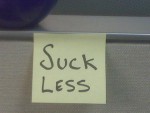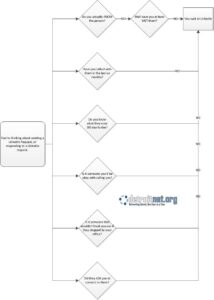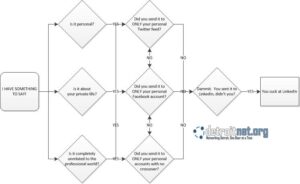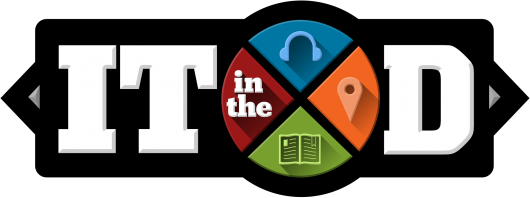Continuing our (relatively new) tradition of helping you not suck, we now move into How Not To Suck At LinkedIn.
We’ll take a look at some of the key areas that cause people to suck at LinkedIn – the profile, groups, statuses, various applications…and hopefully help to keep you from being one of those people who can’t figure out why they don’t have any quality professional connections.
Ready?
Let’s get started…
Test 1: Does Your LinkedIn Profile Suck?

Your profile is the heart and soul of what you do on LinkedIn. If your profile sucks, you’re not going to do well.
So let’s start with the basics, and make sure that you have them covered properly. Please start by clicking on our handy-dandy flowchart to the right to read it before continuing.
IS YOUR NAME IN ALL CAPS? If so, you probably already suck, and we’re just getting started. You don’t need to scream your name at people. Just a simple First Name and Last Name is all you need. It’s not that hard.
Does your tagline (your “Professional Headline”) readily address who and what you are in a clear and concise manner? And for the love of all that’s good and holy in the world, unless you wear all black, slink around at night and kill off 13th century Japanese warlords…you are not a “ninja”. You’re not. Stop it. Similarly, if the words you are using to describe yourself do not appear in a standard dictionary…you suck. You are not “an eHyperMedia Coachultant Experientialist”. There’s no such thing. You are not being innovative, creative, or witty. You are asking for a Three Stooges-style poke in the eye. At a minimum.
 Do you have a photo? More importantly, do you have a photo that your co-workers, boss, and prospective employers should see? Leave the “licking the last drops as they fall out of the tequila bottle” picture for Facebook, party boy. And while we’re at it, you’re looking for professional connections, not someone to help you complete your MRS degree, so let’s keep the bikini photos on the shelf, missy. You don’t need a “professional headshot” or anything like that – you’re expanding your professional network, not going to a casting call for CSI: Detroit. Just a simple photo…of you. Not of “you and your significant other”, not of “you and your dog”, not of “you and your 37 cats”, not of “you and your offspring”…just you. Again, professional networking, not catching up with the family photo albums over coffee. Plus, believe it or not, odds are good that there’s more than one person on LinkedIn with your same name, so a photo makes you quickly and easily recognizable to people.
Do you have a photo? More importantly, do you have a photo that your co-workers, boss, and prospective employers should see? Leave the “licking the last drops as they fall out of the tequila bottle” picture for Facebook, party boy. And while we’re at it, you’re looking for professional connections, not someone to help you complete your MRS degree, so let’s keep the bikini photos on the shelf, missy. You don’t need a “professional headshot” or anything like that – you’re expanding your professional network, not going to a casting call for CSI: Detroit. Just a simple photo…of you. Not of “you and your significant other”, not of “you and your dog”, not of “you and your 37 cats”, not of “you and your offspring”…just you. Again, professional networking, not catching up with the family photo albums over coffee. Plus, believe it or not, odds are good that there’s more than one person on LinkedIn with your same name, so a photo makes you quickly and easily recognizable to people.
Have you read Don’t Be That Guy – Bad Resume Guy? Because as you start to fill out the professional history and employment sections of your profile, you’re basically re-creating your resume. And wouldn’t it be nice if you’d already taken the time to build your resume the right way, so that all you have to do is copy and paste here? Of course it would. So take the time to get your resume right…and you’ll also be making sure that your LinkedIn profile will be solid at the same time.
Can anyone find you? Your home email address should always be your main email address with LinkedIn. Yes, you should also list your work email address as an alternate, because some people may try to find you that way…but your personal email is always your primary. Why? Because even though it would never happen to you, what happens if you suddenly find yourself unable to access that email address any more? What happens if you get locked out of it? Think ahead and be smart. Your professional network is your professional network – not your company’s, not your buddy’s, not anyone else’s…yours. Own it…and make sure you always own it. You don’t have to list a phone number if you don’t want to, but you can always choose to hide it if you do.
Are any achievements, websites, or other “extra” information that you provide professionally oriented? Nobody cares that you were the Tappa Kegga Bru Beer Pong Champion 2006-2010, Skippy. Okay, correct that – nobody that you should be looking to engage with on LinkedIn cares. Similarly, you can leave off the “Winner, Senor Frog’s Wet T-Shirt Contest, Spring Break 2009” accomplishments. You also don’t want to link to your Facebook profile (again, “professional networking”…not “friends”), your church group’s website, or anything else along those lines. Remember, this is basically your online resume – leave anything off of it that shouldn’t matter. It doesn’t matter if you’re married or single. It doesn’t matter that you have eight kids. It doesn’t matter that you got 2000 karma points on the Reddit forums in one post because you embarrassed yourself spectacularly. None of that matters in a professional world…and why would you make it easy for someone to find something out through your profile that they’re not legally allowed to ask you during the interview and hiring process?
Test 2: Do Your Connections Suck?

Have your read LinkedIn is Not a Video Game? If not, go do so now by clicking here. That’s a key foundation to all of this…and to our group…and to networking in general.
There’s a very simple premise here…which is why we can detail the entire thing in that simple flowchart to the right you can click on to view. You only add people as connections that you know well. There are no points for a high score, there is absolutely zero real, tangible benefit to being one of those “open networkers” you hear/see/read about…none. I used to give recruiters a pass on this front, but I’ve since changed my mind about it…and for a good reason.
Let’s say you need to hire a .Net developer. And let’s say that you’ve accepted or created connections with 50 .Net developers completely randomly. You don’t know them, they don’t know you, and you know nothing about them. How is that any different from when a client comes to you and says “I need a .Net developer” and you do a random search? Just because they’re a random connection of yours doesn’t mean anything. They’re no more likely to trust you than if you were to just randomly email them now with your need. You still don’t know if they’re any good. In fact, the only thing you really know about them is that they didn’t know enough to reject a LinkedIn request from someone they didn’t actually know.
And even though you read LinkedIn Is Not A Video Game (because you did, right?) and so you know how we feel about the whole “open networker” or “LION” thing, it bears repeating: don’t do it. We just explained to you why, and there is no solid, rational reason for anyone to be doing this. People have tried to convince us, and they’ve tried to rationalize it. They keep failing.
Test 3: Do Your Status Updates and Linked Applications Suck?

Are you Twittering yourself into a “remove connection” click?
Does your professional network truly need to know how you feel about current political figures?
Do you genuinely think I care what kind of soup you had at lunch with random people that I don’t know or care about either?
Have you violated all of the other Commandments of Networking, and so you’ve decided to just go ahead and annoy the hell out of everyone on every social media platform simultaneously with the same, constant stream of nonsense?
Even if you’re trying to impress a new boss, updating your LinkedIn status every 45 minutes with whatever meeting you’re going to, with whomever you’re going to be meeting with…is over the top. Rampant, over the top insecurity and attention whoring isn’t an attractive feature in a professional connection. So, again: stop it.
In a similar vein, you don’t need to go linking your Pinterest pins to your Twitter tweets to your LinkedIn updates to your Facebook status to your Google+ circles to your blog entries about your life with thirty seven cats. If that didn’t come through loud and clear when you clicked on and read that latest flowchart up there…now we’re spelling it out for you.
Keep your personal and professional life separate. Even if that means setting up multiple email addresses, separate Facebook accounts, different Twitter streams…do it. You’ll thank me at some point in time, I assure you.
And even if you don’t feel that thankful…everyone else will.
I think that’s a good enough starting point for now. If you can pass those three basic tests, you’re at least well on your way to sucking less than a lot of people on LinkedIn…and that’s all we can hope for. We don’t go for “perfect”…we just want things to suck less.
We’ll stop here, and continue on with part two down the road. In the meantime, check out our other How Not To Suck entries at http://www.ITinTheD.com/category/hints/ or the rest of our blog over at http://www.ITinTheD.com/blog/

